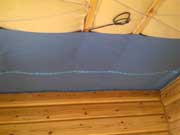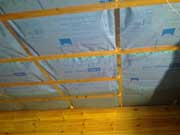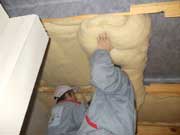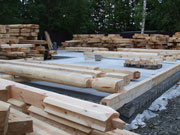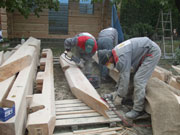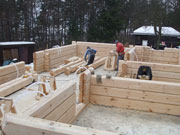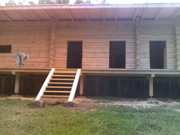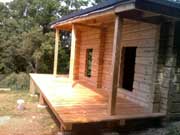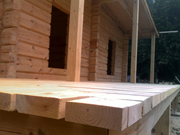Assembly, Impregnation & Roofing
Assembly, Impregnation & Roofing
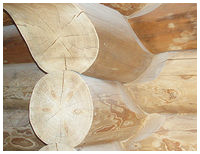 The assembly of the log house is carried out under strict supervision since each component must be placed in its exact location. The individual log house components are delivered, unloaded and positioned in a precise order so that the construction work is as smooth and effective as possible. The log house is erected on site by the same assemblers who have assembled it at the plant. Thereby, fault-free assembly is guaranteed because the assembling team is building up the house for the second time within a very short time period. The method and the speed of the log house assembly differ depending on the used technology. Monivet-Tajga constructs log houses with the aid of the Canadian and Norwegian technology. Special carpentry joints are used in order to ensure adequate strength and tightness. Lighter components are mounted manually, while the heavier bearers are put in their place with the help of a crane. All wooden components are treated with protective coatings paints that, instead of sealing the wood, allow it to breathe.
The assembly of the log house is carried out under strict supervision since each component must be placed in its exact location. The individual log house components are delivered, unloaded and positioned in a precise order so that the construction work is as smooth and effective as possible. The log house is erected on site by the same assemblers who have assembled it at the plant. Thereby, fault-free assembly is guaranteed because the assembling team is building up the house for the second time within a very short time period. The method and the speed of the log house assembly differ depending on the used technology. Monivet-Tajga constructs log houses with the aid of the Canadian and Norwegian technology. Special carpentry joints are used in order to ensure adequate strength and tightness. Lighter components are mounted manually, while the heavier bearers are put in their place with the help of a crane. All wooden components are treated with protective coatings paints that, instead of sealing the wood, allow it to breathe.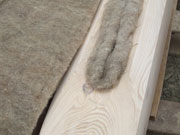 The space between logs is filled with ISOLENA insulation, which is made of natural sheep wool. It prevents heat permeability between the beam and log joints. Its excellent properties make sheep wool insulation the most suitable and irreplaceable material for log structures. The construction proceeds at a fast pace due to the trial assembly at the plant. Moreover, there is no need to make any minor modifications or other additional work. Each component precisely fits in place. During the assembly, guiding tunnels for electric wiring are bored into specific components. This allows the investor to change the placement of lighting or sockets to the very last moment.
The space between logs is filled with ISOLENA insulation, which is made of natural sheep wool. It prevents heat permeability between the beam and log joints. Its excellent properties make sheep wool insulation the most suitable and irreplaceable material for log structures. The construction proceeds at a fast pace due to the trial assembly at the plant. Moreover, there is no need to make any minor modifications or other additional work. Each component precisely fits in place. During the assembly, guiding tunnels for electric wiring are bored into specific components. This allows the investor to change the placement of lighting or sockets to the very last moment.As the construction continues at lightning speed, your house will literally grow before your eyes. The interior partition walls are erected along with the external walls of the house. The house is assembled up to the level of the roof and gable. At this moment, the construction of the roof begins, whereas the most frequent type is a spar truss. Once the truss is in place, each rafter is anchored. The truss is then covered with JUTADACH roof foil and roof battens are put in place to form a grid. Roof insulation differs depending on the used roofing. Finally, the roofer installs the selected roofing material and the wooden structure now bears the weight of the completed roof.
At this moment, a technological interruption is necessary. Its duration depends on the used construction technology and it ranges between 5 to 8 months (Norwegian technology) or 12 to 18 months (Canadian technology). The selected type of wood also influences its length. The main reason for the technological interruption is to allow the log house to dry and settle down (7-10 cm in case of Canadian technology, 3-5 cm in case of Norwegian technology). The individual components as well as the whole structure need to settle, otherwise it would not be possible to precisely measure the window and door openings and to make tailor-made windows and doors.
The next step is to sand and treat the surfaces of all wooden components prior to their preservation. This is a task for wood care specialists who apply exterior and interior protective coating on all components. In this respect, our company uses premium and truly "green" products - i.e. natural oils and waxes. Our experience shows that they are the best possible choice. All wooden components are first impregnated with Bochemit boron salt. The base oil coat is then applied and finally, the top pigmented oil coat is applied which also provides UV protection.
Kreidezeit base oil is mainly made with the use of flax seed varnish and balsamic turpentine oil. The final topcoat oil is mixed with colorants for which we use only high quality baked earth and mineral pigments. After 7 years, the wooden structure is finally impregnated by applying another top layer with pigments whereby the shell of the log house is permanently protected. The wood will become resistant to weather conditions, as well as wood-destroying organisms. The images below show a log house after the completion of all assembly works. The construction material used in this case is pine, which, even after six months and without any treatment, still preserves its typical amber colour. This is namely due to winter felling, the quality of the trees and the elevation of the region where the wood originated.
Completion of Assembly – Preparation for Impregnation.
![]() Phase 3. - Foundation Slab || Phase 5. - Window, Door Installation & Finishing Work
Phase 3. - Foundation Slab || Phase 5. - Window, Door Installation & Finishing Work ![]()
Preparation Phase||Production & Transport
